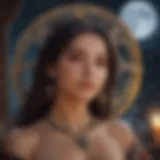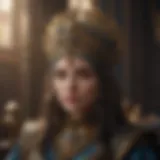Exploring the XIII Tarot Card: Significance and Interpretations
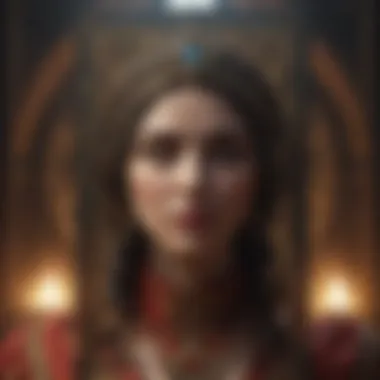

Intro
The XIII tarot card, commonly recognized as Death, often evokes a sense of dread or misunderstanding among many. However, this card embodies profound transformation and renewal rather than an end. Its symbolism weaves a narrative of change, urging practitioners and seekers to comprehend its context deeply. This article aims to navigate through the layers of meaning associated with the XIII card, examining its significance within the tarot deck and its implications during readings.
In the following sections, we will explore the card’s historical background, the essence of its imagery, and how it interacts with other tarot symbols. Interpretations will be examined from both upright and reversed perspectives, highlighting the card's multifaceted role in divination. The goal is to foster an understanding that enhances not only individual tarot practice but also enriches the broader field of esoteric knowledge.
Understanding the Tarot Deck
The Tarot deck is a crucial element in the study of tarot reading, as it serves as a medium through which insights into life and its complexities can be explored. Understanding the Tarot deck provides a foundation for interpreting cards, including the XIII card known as Death. This knowledge aids practitioners—both novice and experienced—in deepening their connections to the cards, thus enhancing readings.
History of Tarot
Early Origins
The origins of Tarot can be traced back to the 15th century, primarily in Europe. Initially, Tarot cards were not used for divination but were played as a card game called tarocchi. This early form reflects some aspects of court life and societal views at that time. The blend of art and function in these cards offers an intriguing aspect of history that leads into the modern understanding of the Tarot. The key characteristics of these early cards were their use of rich imagery, which created a visual language that artists and historians find beneficial for analysis.
The unique feature of the early Tarot is its transformation over time. It transitioned from a game to a tool for reflection and insight. Some scholars argue about the impact of this transition. It can illuminate the profound meanings embedded in the cards, enriching the overall understanding of Tarot as an esoteric practice.
Development Through the Ages
As centuries passed, Tarot evolved significantly. The introduction of mystical interpretations in the 18th century marked a pivotal moment in its development. This cultural shift propelled Tarot into a realm of spirituality and divination. The key characteristic during this period was the definitive association of Major Arcana cards with archetypal energies. This connection remains a popular focus in contemporary practices, making it a substantial choice for this article.
Notably, the unique feature of Tarot's development is its diversity, reflecting various cultural influences and personal interpretations. The evolution allowed Tarot to adapt, ensuring its relevance in modern spiritual contexts. The clear understanding of Tarot's journey through time helps emphasize the significance of individual cards and their meanings in modern readings.
Structure of the Tarot Deck
The Tarot deck is structured into two main parts: the Major and Minor Arcana. This structure is essential for grasping how tarot readings function, as each part symbolizes different aspects of life and experience.
Major Arcana
The Major Arcana consists of 22 cards that represent significant life events, themes, and spiritual lessons. Each card carries substantial weight in readings, often highlighting major influences or turning points. The key characteristic of the Major Arcana is its connection to archetypes and universal themes, which makes it a crucial area of study in understanding Tarot. The focus on these archetypal symbols offers valuable insight for practitioners aiming to interpret the XIII card effectively within a broader context.
A unique feature of this aspect is that Major Arcana cards invite profound contemplation. Recognizing their importance can lead to transformative experiences in readings, providing an avenue for deeper personal understanding.
Minor Arcana
The Minor Arcana consists of 56 cards and is divided into four suits, much like a playing card deck. These cards represent everyday situations and experiences, providing nuanced insights into daily life events. The key characteristic of the Minor Arcana lies in its focus on the mundane and ephemeral, balancing the heavier themes of the Major Arcana. This balance is essential for comprehensive readings.
The unique aspect of the Minor Arcana is its connection to personal experiences and minor influences. While these cards may seem less significant compared to their Major counterparts, they play a vital role in narrative structure during readings. Understanding how the Minor Arcana interacts with the Major Arcana enriches the overall reading, leading to a more rounded interpretation.
The Role of the Major Arcana
The Major Arcana holds a crucial place in the tarot deck. Comprised of 22 cards, these symbols carry deep, universal meanings. Unlike the Minor Arcana, which can often reflect day-to-day events, the Major Arcana illustrates significant life themes and lessons. Understanding their role enhances readings and interpretations. These cards represent fundamental aspects of existence, often tied to larger forces at play in one’s life. The XIII card, known as Death, is notably one of these pivotal cards, embodying profound transformation.
Significance of Major Arcana Cards
Archetypes in Tarot
Archetypes are foundational symbols that represent common human experiences. The Major Arcana is rich in archetypes, facilitating a deeper connection to readers' subconscious. Each card embodies characteristics embodying universal themes like journey, challenge, and transformation.
The XIII card fits into these archetypes as a representation of dramatic change. Its meaning often extends beyond mere endings, encapsulating the potential for new beginnings. This characteristic makes it a significant focus in any tarot study. Readers find value in the depth these archetypes bring, enhancing interpretive richness in readings.
Moreover, archetypes help in integrating personal insight. While the archetype of Death may conjure fear, working with its deeper meanings can illuminate pathways of renewal. This dichotomy of endings bringing growth offers a nuanced layer for practitioners to explore during sessions.
Influence on Readings
The influence of the Major Arcana in readings cannot be overstated. When they appear, they command attention and signal pivotal moments. This distinctive feature shapes the overall narrative of any tarot layout. The XIII card, with its implications of transition, can reshape the context of surrounding cards significantly.
By emphasizing the profound impacts of the Major Arcana, tarot practitioners can navigate readings with more clarity. The presence of these cards often requires a deeper interpretation, challenging surface-level assumptions about situations. As a result, the Major Arcana can help readers identify crucial life shifts, crafting a more comprehensive understanding.
Preface to the Card
The XIII card, named Death, stands out as one of the most misunderstood cards in the tarot. Its name often invokes apprehension, yet its importance is foundational to a complete tarot understanding.
Name and Symbolism
The name "Death" in tarot carries significant weight. It is critical to approach this term with care, recognizing it symbolizes transitions rather than a literal end. The imagery often associated with this card features skeletal figures, a clear representation of mortality. However, its symbolism extends beyond physical death to essential transformations in life.
This aspect opens conversations about releasing the old to usher in the new. Practitioners find it beneficial to emphasize this duality when interpreting the card. This enhances their readings, focusing on growth rather than loss. Ultimately, the unique feature of naming resonates differently with each reader, as people often react based on their personal experiences with change.
Connection to Transformation
The connection to transformation plays a central role in interpreting the XIII card. This aspect transcends simple endings, indicating the cyclical nature of existence. Life is a series of transformations; thus, this card captures that essence profoundly. Many interpret the presence of this card as a call to embrace inevitable shifts, urging readers to welcome them.
Moreover, this connection reinforces resilience. Each transformation leads to revitalization, which is crucial for personal growth. Readers can draw on this understanding to provide nuanced interpretations, helping clients navigate personal challenges and transformations. The XIII card, in recognizing the beauty of transformation, offers indispensable insights into life’s complexities.
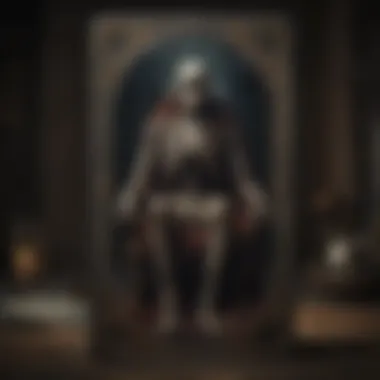

Symbolism of the Card
The XIII Tarot Card, often termed as the Death card, carries profound significance in tarot readings. Its symbolism extends beyond mere interpretations of endings or mortality. Instead, this card encapsulates the essence of transformation and renewal. Understanding the symbolism connected to this card allows both novice and seasoned readers to grasp the nuanced implications during readings.
Imagery and Design
Common Symbols Used
The design of the XIII card incorporates several common symbols that enhance its interpretative depth. Prominently featured are elements like the skeletal figure, representing mortality, and the landscape backgrounds, which often depict barren lands or imagery of rebirth such as flowers. These elements are not simply decorative; they serve as catalysts for interpretation. Each symbol conveys rich meanings that can provide insights into the querent's life circumstances. The skeletal figure, for instance, emphasizes the inevitability of change, while the flowers symbolize new growth following endings. This duality is a beneficial aspect of the card as it reinforces the concept of transformation, providing a well-rounded approach to readings.
Interpretive Variations
Interpretive variations of the XIII card add to the richness of tarot reading experiences. Within different tarot traditions and decks, this card's imagery can slightly change – for example, some decks portray scythes or inverted imagery representing stagnation. Such variations allow for flexible interpretations based on the context. For instance, a scythe might emphasize the cutting away of old patterns, while an inverted card could indicate resistance to this necessary change. This characteristic makes interpretive variations powerful, as they enable readers to tailor their readings to fit specific contexts, personal circumstances, and the querents’ emotional states.
Cultural Interpretations
Western Views
In Western tarot traditions, the Death card is often associated with fear and misconceptions. Many view it solely as an ominous sign of death, which can lead to anxiety in the querent. However, a deeper understanding reveals that in most interpretations, it symbolizes new beginnings and the necessity of change. This perspective can be both a strength and a limitation. While it challenges practitioners to communicate positive aspects of transformation, it can be difficult in readings focused solely on loss or change. Thus, articulating its broader implications is crucial for accurate readings.
Global Perspectives
When considering global perspectives on the XIII card, the interpretations differ widely. In some cultures, death is viewed as a natural passage, an essential step in life circles. For example, in certain Indigenous traditions, death is linked to ancestor reverence and continuity through the cycles of nature. Understanding these perspectives enhances a reader’s toolkit, enabling them to approach readings with cultural sensitivity and awareness. This allows for a richer dialogue with querents from diverse backgrounds, making the card's framework more inclusive.
"The symbolism of the XIII card is not merely about endings but is deeply rooted in the philosophy of growth and regeneration."
Integrating these aspects of symbolism into tarot practice enriches the interpretative process. With careful consideration of imagery, variation, and cultural context, the XIII card opens avenues for deeper understanding and insight in tarot readings.
Reading the Card Upright
Reading the XIII card in its upright position is pivotal to understanding its full significance. This card, known as Death, represents profound transformations rather than an end in a literal sense. Interpreting this card correctly can provide the querent with valuable insights into their current life circumstances. It can initiate meaningful conversations about change and growth. Practitioners should feel empowered to explore its deep meanings alongside the querent's context.
Core Meanings
Endings and Beginnings
The concept of Endings and Beginnings is central to the XIII card's interpretation. This duality reflects life cycles, showing how the end of one phase naturally leads to the start of another. Many people fear the finality associated with endings, but this perspective is essential for understanding the dynamics of growth.
This particular aspect is beneficial because it encourages individuals to reframe their experiences. The key characteristic here is transformation. It signifies the release of something obsolete, making way for new opportunities.
One unique feature of this interpretation is its ability to evoke resilience. It allows the reader to identify where they might be holding onto past pain or reluctance to change. The advantage lies in fostering a perspective that emphasizes adaptation and readiness for renewal.
Cycles of Life
Exploring the Cycles of Life offers another layer of understanding to the XIII card. This emphasizes the natural flow of existence. It highlights that just as seasons change, so too do life circumstances. It's about acknowledging the rhythm of life and how each cycle contributes to personal development.
The key characteristic of this aspect is the acknowledgment of continuity. This understanding is relevant for tarot readings as it provides emotional grounding. The unique feature here is the resolution to ongoing struggles, making it a popular approach in readings.
This also has its advantages and disadvantages. While it brings comfort in knowing that challenges are often temporary, it can lead some to overlook immediate challenges due to the focus on long-term cycles. Balancing these perspectives is crucial for insightful readings.
Contextual Considerations
When interpreting the XIII card, contextual considerations play a vital role. This involves understanding the querent's situation, influencing the card's message. It is not merely about the card itself, but also about how it interacts with the specific question posed and surrounding cards.
Questioning Aspect
The Questioning Aspect is significant when reading the XIII card. The question a querent brings shapes how the card's meanings unfold. It reflects their unique experiences and thoughts surrounding change. This aspect encourages both the reader and the querent to engage in a thoughtful dialogue about personal challenges.
The key characteristic here is introspection. By focusing on the right questions, the reader can help the querent uncover deeper truths about their circumstances. This is especially beneficial for nurturing understanding and acceptance.
The unique feature of this aspect is that it creates space for exploration. However, it requires careful navigation. A poorly framed question can lead to confusion or misinterpretation of the card's meanings. Attention to detail is important to ensure clarity.
Surrounding Cards
The influence of Surrounding Cards cannot be understated. Each card in a spread interacts with the others, shaping how they collectively inform the reading. The context provided by surrounding cards offers additional depth to the interpretation of the XIII card.
The key characteristic of this consideration is the interconnectedness of meanings. This holistic view enhances clarity and understanding. It is beneficial as it allows the reader to contextualize the XIII card's message within a broader narrative.
The unique feature of examining surrounding cards lies in its interpretative richness. It provides the opportunity to draw links to other areas of life, revealing new insights. However, the challenge lies in not becoming overwhelmed by too many variables. Structuring the reading in a coherent manner is essential.
Interpreting the XIII card upright requires attention to both its inherent meanings and the unique context of each reading.
Recognizing the interplay of core meanings and contextual factors is crucial for offering profound insights to querents. Readers should cultivate a thoughtful approach to interpreting the XIII card, enriching their tarot practice.
Interpreting the Card Reversed
Interpreting the XIII Tarot card in its reversed position carries significant weight in any tarot reading. The reversed position highlights different meanings and implications compared to its upright stance. It speaks to the nuances of human emotions and experiences. This section will address critical themes of the reversed XIII card and how they relate to the broader context of tarot readings.
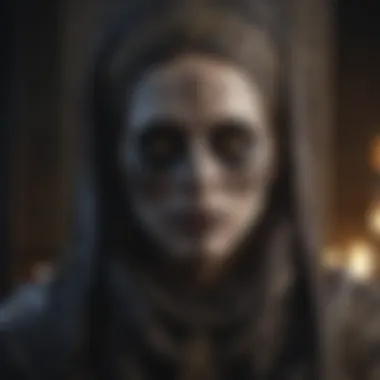

Meaning of Reversal
Resistance to Change
Resistance to change is a core theme when the XIII card appears reversed. This concept captures the struggle individuals face when confronted with inevitable transformations in life. It suggests a reluctance to let go of old habits or situations that may be counterproductive. The very nature of this resistance can stall personal growth and hinder progress. In this article, this aspect is crucial because it shines a light on how individuals often grapple with change, even when they know it might be beneficial. Analyzing this aspect provides the audience deeper insight into the complexities of human behavior.
The key characteristic of resistance to change is its powerful hold on emotions. This situation can lead to feelings of stagnation, potentially fostering despair or anxiety. The unique feature of resistance lies in its duality; it can act as both a protective mechanism and an obstacle to growth. This duality provides a rich ground for examination within the context of tarot readings. By acknowledging resistance, practitioners can guide querents toward recognizing and confronting their own blockages.
Fear of Transformation
Closely related to resistance, fear of transformation emerges prominently with the reversed XIII card. This fear often stems from uncertainty about what lies ahead, leading people to cling to the familiar, even if it’s detrimental. Acknowledging this fear is important in tarot interpretations, as it affects how individuals approach life changes and decisions. The theme of fear is powerful, as it can paralyze individuals, preventing them from making necessary choices.
The key characteristic of fear of transformation is its pervasive nature. This emotion transcends conscious thought, often lurking in the subconscious mind. It lays the groundwork for hesitation in personal evolution, making this concept popular in tarot literature. Describing the unique aspect of this fear, it can open a pathway toward deeper reflection. However, the disadvantages include a continuous cycle of avoidance that limits potential. This understanding expands the practitioner's ability to navigate readings effectively, shedding light on the querent’s internal struggles.
Application in Readings
Reevaluation of Situations
When reading the XIII card reversed, one significant application is the reevaluation of situations. This process compels querents to assess their current circumstances critically. It urges them to reflect on what must change, or what should be maintained in their lives. This theme is vital, as it prompts self-examination, leading to potential breakthroughs. Practitioners can emphasize this aspect during readings to guide individuals toward clarity.
The key characteristic of reevaluating situations lies in its transformative potential. When individuals engage in this introspection, they can unveil deeper truths about themselves and their environment. The unique feature of this reevaluation lies in its practicality. It offers a tangible way for querents to confront fears and resistances. However, it still requires dedication and sincerity, which may be challenging for some. Nonetheless, it serves as an invaluable tool for personal development.
Emotional Reflections
The reversed XIII card also encourages emotional reflections. It prompts individuals to look inward and address feelings that their situations may have evoked. Often, this card speaks to anxiety or dread that accompanies changes. Engaging with these emotions is crucial, as they influence how one reacts to life’s transitions. This reflective process is particularly beneficial within a reading context, enhancing the connection between the querent and the interpretation.
The key characteristic of emotional reflections is its depth. This introspective approach allows for exploring subconscious thoughts and feelings. This is a popular choice for tarot reading, as it aligns well with the quest for understanding oneself and one’s emotions. The unique feature lies in its comfort; it often leads to moments of clarity. Nevertheless, it may also unearth uncomfortable feelings that require careful handling. Despite the challenges, engaging with these reflections can be an enlightening experience that fosters acceptance and healing.
Connecting the Card to Other Major Arcana
The interaction between the XIII card, often referred to as Death, and the other Major Arcana cards is crucial in tarot reading. Understanding these connections helps in interpreting the profound implications the XIII card can have in a reading. The relationships suggest a deeper narrative within the tarot deck that extends beyond individual card meanings. This section offers insights into how the XIII card interacts with other Major Arcana cards, enriching the reading experience and providing a comprehensive understanding of its role.
Card Relationships
Symbolic Connections
Symbolic connections between the XIII card and other Major Arcana cards highlight the multifaceted nature of death and transformation. The XIII card does not exist in isolation; it is intertwined with cards such as the IX of the Hermit, which represents introspection, and the XVI Tower, signifying unforeseen change. For instance, while the XIII card signifies endings, the IX card can emphasize the need for solitude in processing these changes. This symbolic relationship enriches the narrative, prompting reflections on how transformation and contemplation work hand in hand.
The primary characteristic of these symbolic connections lies in their storytelling aspect. They create an integrated narrative, guiding the querent through a journey of understanding. By emphasizing connections such as these, readers can draw out deeper insights from the cards presented in a reading. A unique feature of these symbolic networks is their ability to reveal hidden facets of the querent's situation, making them a potent tool for any tarot practitioner.
Influence on Readings
The influence of the XIII card on readings is significant and multifaceted. When placed alongside cards like the II High Priestess, a conversation about intuition arises. This connection reinforces the idea that while change may be daunting, it brings forth new perspectives. The transformations indicated by the XIII card can signify the necessity to engage with one's inner self and trust one's instincts, deepening the reading's impact.
The key characteristic here is the interplay of meanings. The cards adjacent to XIII can shift the focus of the reading dramatically. For example, a surrounding card that suggests stagnation may indicate a need for drastic change, amplifying the XIII’s message. The advantage of this is that readings become more contextual and personalized. However, the challenge lies in ensuring clarity in communicating these influences to clients, as connections can sometimes confuse the broader message of the reading.
Sequential Importance
Navigate Through the Journey
Navigating through the journey of tarot interpretation underscores the sequential importance of the XIII card. Within the Major Arcana, the progression of cards often tells a story, and the XIII card acts as a pivotal point symbolizing significant transformation. This card's placement influences how one approaches subsequent cards, creating a roadmap for personal development.
This characteristic is beneficial because it encourages a dynamic interpretation of each card in relation to the card that precedes or follows it. It emphasizes the importance of understanding where one has been in the narrative to appreciate where one is heading. The unique feature here is the cyclical understanding of tarot, as each reading reflects a different aspect of life's journey.
Lifecycle of Personal Growth
The lifecycle of personal growth is another concept intertwined with the XIII card. This card depicts not just an ending, but an invitation to growth, evolving from past experiences. Each reading using the XIII card can be a representation of personal milestones—a symbolic marker of what has been outgrown and what new potential awaits in the unknown.
The key characteristic here is the inherent optimism within transformation. While endings may appear frightening, they often yield room for new beginnings. This makes the XIII a powerful card for those seeking to understand their personal evolution. One unique aspect is how this card can shift the focus of readings, prompting deeper reflections on self-discovery and growth. However, it also carries the challenge of confronting discomfort associated with change, which may not be easy for all querents.
In summary, the connections and sequential importance of the XIII card enhance the depth of tarot readings, offering avenues for insight and understanding the reader's journey through transformation.
Practical Tips for Reading the Card
Understanding how to approach the XIII card is essential for both novice and experienced tarot readers. The importance of practical tips cannot be overstated, as they provide necessary guidance when interpreting this complex card. By considering various aspects of reading the XIII card, practitioners can improve their accuracy and deepen their insights.
Building Intuition
Personal Connections
Personal connections play a crucial role when interpreting the XIII card. Every reader brings unique experiences, emotions, and ideas to their practice. These individual factors shape one’s understanding, helping to create a more tailored experience for the querent. Personal connections allow readers to feel more engaged and authentic in their readings. This is a beneficial choice because it fosters empathy and intuitive clarity.
Readers should try to reflect on their own life experiences related to moments of significant change or transformation. This engagement can enrich interpretations and lead to deeper discussions with querents. However, reliance on personal connections can also pose risks if readers become too biased by their experiences.
Fostering Insight
Fostering insight is integral to understanding the complexities of the XIII card. It involves not only comprehending its meanings but also being open to various interpretations that may arise during a reading. The key characteristic here is flexibility. Flexibility allows readers to adapt their interpretations as new information or contextual cues emerge during a session. This quality makes it a popular choice for enhancing reading accuracy.
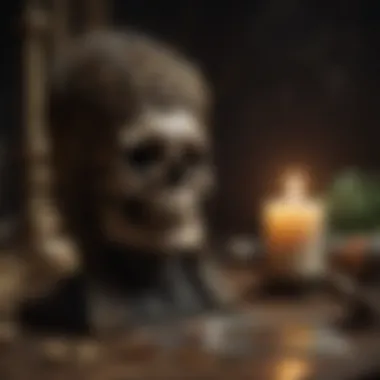

A unique aspect of fostering insight is the ability to cultivate a deeper connection with the tarot's symbolism. Engaging with the cards beyond superficial meanings can unveil hidden truths. However, too much openness can lead to confusion, so balancing this insight with structured interpretations is crucial.
Contextual Strategies
Aligning with the Querent
Aligning with the querent is an important strategy when interpreting the XIII card. This aspect emphasizes the need to understand the querent's perspective and emotional state. Such alignment contributes to a more meaningful and personalized reading, enabling the reader to tailor their insights specifically to the querent’s situation. This method is beneficial in creating appropriate interpretations that meet the needs of the querent.
A significant feature of this approach is the emphasis on communication. Encouraging the querent to express their feelings and thoughts can enhance the overall reading experience, making them feel valued and supported. However, misalignment can occur if the reader fails to engage fully, leading to misunderstandings or inadequate insights.
Adapting Interpretations
Adapting interpretations is another key strategy for successful readings of the XIII card. The changing dynamics within each reading can lead to new insights that require adjustments in analysis. This approach enhances the reader's ability to respond to varying situations and emotional states of the querent.
A critical characteristic of adapting interpretations is the focus on situational context. Readers who can pivot their meanings based on immediate circumstances tend to provide richer, more relevant insights. The advantage here is that it enhances the accuracy of readings, aligning the message of the card with the querent's life. However, this flexibility can sometimes lead to over-analysis or inconsistency in interpretations if not managed carefully.
"The XIII card offers both endings and beginnings. Each reading can change based on context and the unique journey of the querent."
Common Misconceptions About the Card
Understanding common misconceptions surrounding the XIII tarot card is essential for both practitioners and enthusiasts. This card, often referred to as Death, shrouded in negative connotations, can lead to misinterpretations. Addressing these misconceptions not only clarifies its meanings but also enriches one’s tarot reading experience. It is crucial to engage with this card's deeper implications, which can ease fear and anxiety often associated with it.
Misconceptions often stem from cultural myths and media portrayals. Exploring these misreadings can lead to a healthier understanding of transformation and mortality.
Misreadings of Death
Understanding Mortality
Understanding mortality involves grasping the inevitability of change and life cycles. The XIII card symbolizes this aspect deeply. One common misreading is perceiving it solely as a harbinger of physical death. This limits its interpretations only to the end of life. The actual significance encompasses broader themes of transformation, transition, and renewal. Many people are drawn to death as an end, neglecting the possibility of a new beginning.
Key characteristics of understanding mortality here include the ability to view death as a part of life. This perspective encourages individuals to embrace the cyclical nature of existence and teaches them to find value in endings as precursors to new opportunities.
Unique to this aspect is the advantage of promoting acceptance of life transitions. This acceptance, however, can become disadvantageous if one becomes too fixated on loss, overlooking the potential rebirth or new journeys that follow.
Embracing Change
Embracing change reflects the active participation in life's transitions. The XIII card promotes the idea of letting go and welcoming what follows. Misunderstanding this aspect can inhibit personal growth. When individuals view change with fear, they miss the chance for reevaluation and improvement in their lives.
One key characteristic of embracing change is the liberation it offers. The act of letting go can lead to new experiences, growth, and realizations about oneself and one's path. This perspective is often chosen for discussions around the XIII card due to its transformative potential.
A unique feature of embracing change involves the encouragement of adaptability. However, the disadvantage may come when the fear of change leads individuals to resist necessary transitions. This resistance can stifle personal development.
Cultural Myths and Realities
Stereotypes of Tarot
Stereotypes surrounding tarot evoke mixed reactions. They often depict tarot cards, especially the XIII, as mystical tools solely for predicting doom. These stereotypes can shape public perception negatively, limiting understanding of the genuine wisdom tarot offers. The reinforcement of these views does a disservice to the nuanced interpretations of tarot.
A key characteristic of stereotypes of tarot is the oversimplification of its purpose. Many view it merely as a fortune-telling device, disregarding its capacity for reflection and personal growth. This viewpoint is significant because it highlights the need for education on tarot's true role.
The disadvantage of these stereotypes lies in their potential to deter individuals from exploring tarot further. Many may miss the transformative and healing aspects of cards like the XIII, resulting in a shallow understanding of their applications.
Positive Aspects
On the other hand, recognizing the positive aspects of the XIII card can clarify its role in personal journeys. The assumptions around it being purely negative contradict its transformative nature. When viewed in a more favorable light, the XIII card signifies endings that facilitate new beginnings, fostering courage in the face of change.
The essence of positive aspects focuses on its encouraging nature for those seeking growth. It embraces themes of renewal and new perspectives that enhance personal development. This is crucial as it allows the card to serve as a guide for introspection and growth.
A distinct feature here is how acknowledging the positives can lead to better acceptance of life's unpredictability. However, focusing solely on its positive traits can oversimplify complex emotions and experiences tied to endings, which must also be acknowledged.
Overall, addressing these misconceptions allows for a richer understanding of the XIII card. By interpreting it within the context of life as a series of cycles, readers can unlock its potential as a source of insight and guidance, leading toward a more profound appreciation of tarot.
Epilogue on the Tarot Card
In reviewing the XIII Tarot Card, which is often referred to as Death, it becomes clear that its significance extends far beyond mere mortality. This card embodies transformation, illustrating the perpetual cycle of life. This conclusion emphasizes that understanding this card can enhance tarot practice significantly. Readers should recognize that the XIII card is not merely about endings; it encourages them to embrace new beginnings that follow. The card serves as an invitation to explore the depths of personal transitions and the revelations that come as a result of change.
The insights gathered throughout this article are vital for both novice and advanced tarot practitioners aiming to deepen their interpretive skills. Recognizing the full scope of what the XIII card represents helps in comprehending its influence during readings. It is essential to acknowledge the nuanced meanings, both positive and negative, that can arise when this card is drawn, thus enriching the overall interpretative landscape of tarot reading.
Summarizing Insights
Key Takeaways
The core contribution of Key Takeaways in this exploration is the understanding that the XIII card signifies more than an end. It is a profound opportunity for growth and renewal. By establishing this key characteristic of the card, it becomes evident that recognizing its transformative qualities can lead to significant benefits in readings. This understanding aids the reader in leveraging the themes of change and acceptance in their encounters with querents.
One unique feature of these Key Takeaways is their ability to highlight the recurrent theme of transition in the tarot journey. Such recognition can guide practitioners in facilitating meaningful discussions with those seeking insight through tarot readings.
Future Directions in Practice
Future Directions in Practice focuses on the application of insights gained from the XIII card. This element allows practitioners to consider how the card's transformative energy can inform personal practices moving forward. Emphasizing adaptability and openness in future readings reinforces the card's intended lesson of embracing change.
The unique feature of these Future Directions lies in their utility for both personal growth and professional development. Practitioners can use the insights around the XIII card to develop deeper connections with their querents, encouraging a more profound exploration of their life circumstances.
By consciously integrating these lessons into daily practices, tarot practitioners stand to benefit from a broader, more nuanced understanding of the dynamics represented by the XIII card, thus further enriching their tarot experience.
